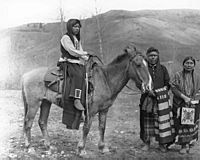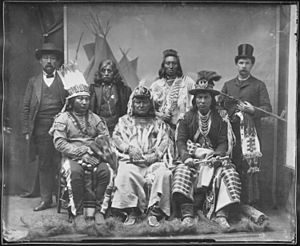Palouse people facts for kids

Palouse-Colville Family (1905)
University of Washington Digital Collections |
|
| Regions with significant populations | |
|---|---|
| Languages | |
| English, Salishan, Sahaptin | |
| Related ethnic groups | |
| Colville, Sanpoil, Nespelem, Sinixt, Wenatchi, Entiat, Methow, Southern Okanagan, Sinkiuse-Columbia, and the Nez Perce of Chief Joseph's band |
The Palouse /pəˈluːs/ are a Sahaptin-speaking Native American tribe. They were recognized in a treaty with the United States in 1855, along with the Yakama people. This agreement was made at the 1855 Walla Walla Council. Another way to spell their name is Palus.
Today, many Palouse people are part of the federally recognized Confederated Tribes and Bands of the Yakama Nation. Some are also members of the Colville Confederated Tribes, the Confederated Tribes of the Umatilla Indian Reservation, and the Nez Perce Tribe.
Contents
About the Palouse People
The Palouse are one of several Sahaptin-speaking groups of Native Americans. They traditionally lived on the Columbia Plateau in parts of eastern Washington, northeastern Oregon, and North Central Idaho. Other groups in this area included the Nez Percé, Cayuse, Walla Walla, Umatilla, and the Yakama.
Palouse Lands and Lifestyle
The traditional lands of the Palouse people stretched from where the Snake and Clearwater Rivers meet in the east, to where the Snake and Columbia Rivers meet in the west. This area included the Palouse River Valley. They lived in three main regional groups, each made up of several village communities.
- Upper Palouse Band: These groups often lived alongside parts of the Nez Perce people. Their villages were along the Clearwater River. Today, some are part of the "Confederated Tribes of the Colville Reservation" and the "Nez Perce Tribe."
- Middle Palouse Band: They lived along the Palouse River and the Lower Clearwater River. Their main village, called Pa-luš-sa/Palus, was at the meeting point of the Palouse and Snake Rivers. This village gave its name to the entire Palouse tribe. Most of these people are now part of the "Confederated Tribes and Bands of the Yakama Nation."
- Lower Palouse Band: These groups lived along the Lower Snake River, down to where it joins the Columbia River. Today, they are mostly part of the "Confederated Tribes and Bands of the Yakama Nation."
The Palouse people were nomadic, meaning they moved around to find food throughout the different seasons. They would gather with other Native American groups for activities like hunting, fishing, trading, and celebrations. They lived near tribes such as the Nez Perce, Wanapum, Walla Walla, Umatilla, and Yakama.
The name "Palouse" likely comes from the Middle Palouse Band's name for themselves, Palúšpam, meaning "people of Pa-luš-sa." Their own name for themselves was Naxiyamtama or Naha’ámpoo/Naha'u'umpu'u, which means “the river people.”
Palouse and Horses
The Palouse people were skilled horse riders. The famous horse breed, Appaloosa, probably got its name from the term "A Palouse horse." The Palouse bred these horses for their unique spotted markings. In the late 1800s, during conflicts with the United States, the U.S. Army captured and killed many tribal horses. This was done to weaken the tribe.
Palouse History: Important Events
In October 1805, explorers Lewis and Clark met with the Palouse tribe. Most of the people were away hunting and gathering food at the time. Lewis and Clark gave a special silver peace medal to the main chief, Kepowhan. The explorers' journals described the Palouse as a separate group from the Nez Percé.
Leaders and Conflicts
After Chief Kepowhan, other important leaders emerged in the 1830s, 1840s, and 1850s. These included Wattaiwattaihowlis, Kahlotus, Soei, Nehtalekin, and Tilcoax.
In 1855, when the Isaac I. Stevens Treaty was being negotiated, the Palouse refused to sign it. However, they sent Kahlotus, Tilcoax, and Slyotze as observers. "Old" Hathalekin and Tilcoax led Palouse warriors in conflicts against U.S. troops between 1847 and 1848. In 1858, Tilcoax again led Palouse warriors in what was called the "Skitswish (Coeur d'Alene) War." During this time, the Palouse managed to capture some Army horses. However, on September 8, 1858, U.S. soldiers killed 800 of their own horses, and the Palouse surrendered.
Later, Husishusis Kute, a chief from the Wawawai Palouse, and "Young" Hathalekin, a war-chief, led a small group of Palouse as allies of Chief Joseph and his Nez Perce band. "Young" Hathalekin died fighting in 1877. Husishusis Kute surrendered with Chief Joseph in October 1877.
Important Palouse Leaders
- Tilcoax ("Wolf Necklace"): He led Palouse warriors during the Skitswish (Coeur d'Alene) war in 1858. He fought against U.S. Army troops.
- Hahtalekin (also known as Taktsoukt Jlppilp – “Echo” or “Red Echo”): He was a chief of the Palus Band, who lived where the Snake and Palouse rivers meet. His group was known for hunting buffalo. During the flight with the Nez Perce, he led 16 men.
See also
 In Spanish: Palus para niños
In Spanish: Palus para niños


